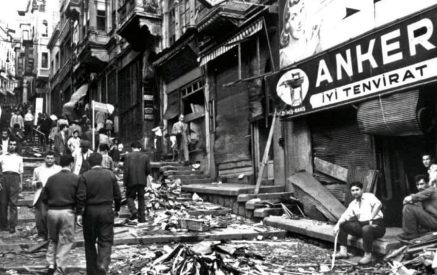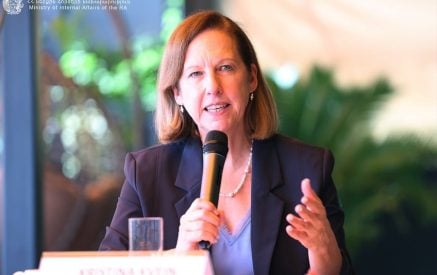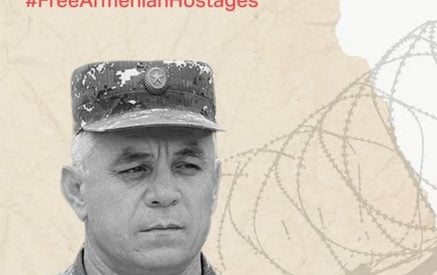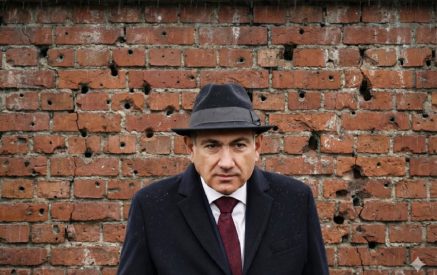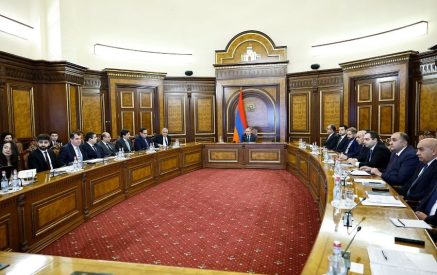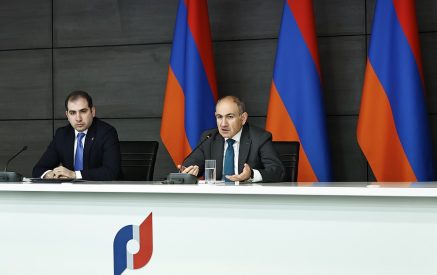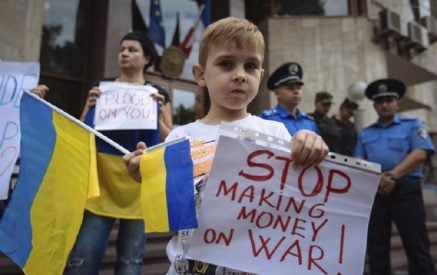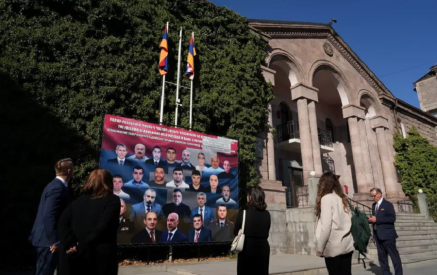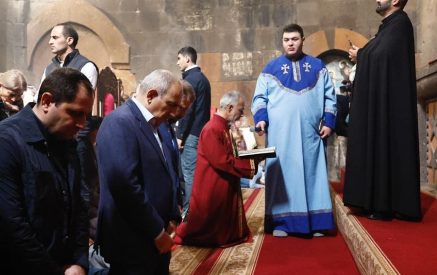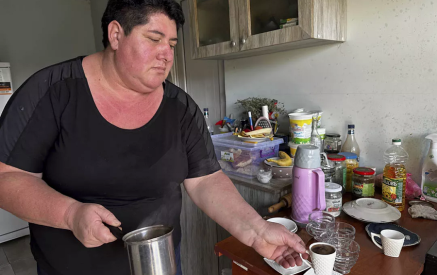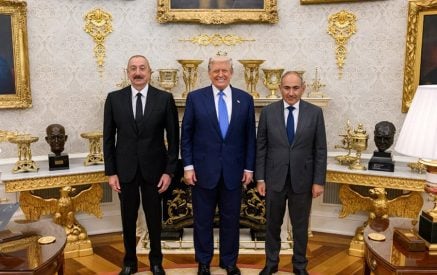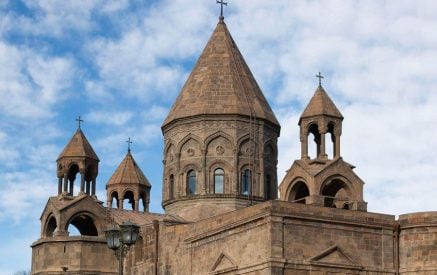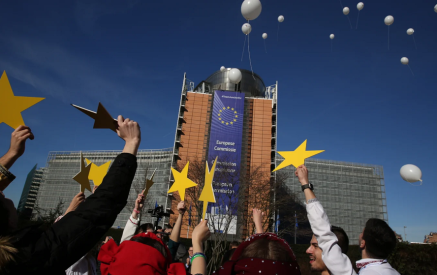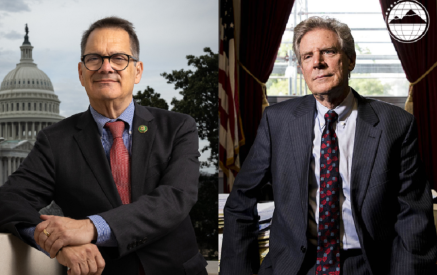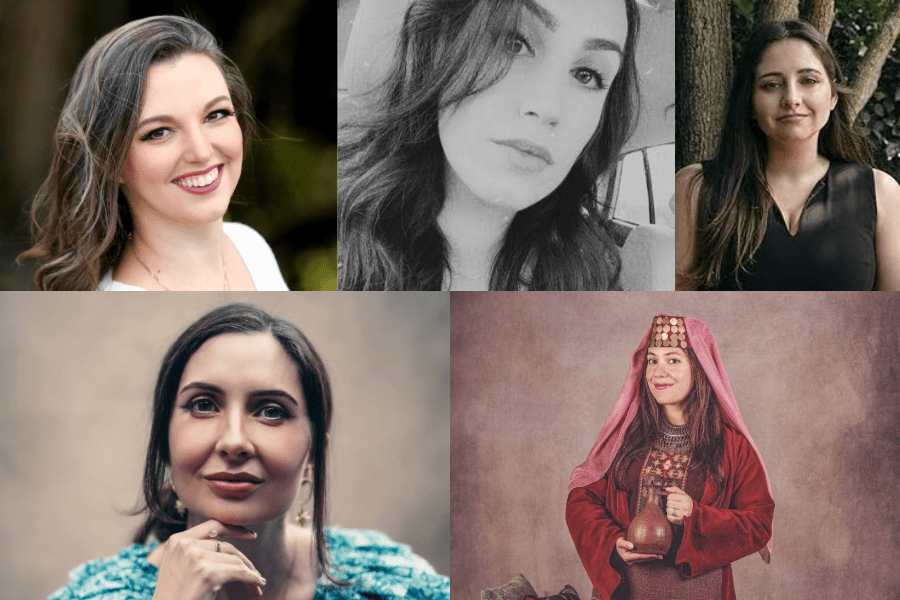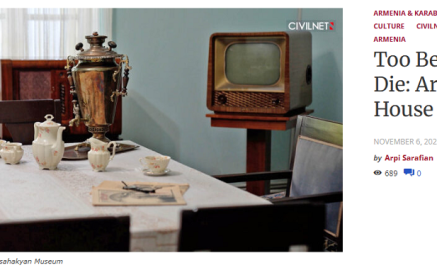Armenian Weekly. An interview with Alyssa Jarrett, Gissane Sophia, Jeanette Rose, T. (Tamar) Isajanyan and Taleen Voskuni
Editor’s note: From Silicon Valley meet-cutes to ancient myths reimagined, the voices of Armenian romance authors are as diverse as the diaspora itself. In this panel, five writers reflect on how Armenian identity shapes their storytelling, characters and creative process.
Alyssa Jarrett, author of Love and Paklava, brings wit and warmth to the tech world through her steamy Silicon Valley rom-coms. Gissane Sophia, author of A Certain Step, blends vulnerability and emotional depth in stories that celebrate found families and slow-burn romance. Jeanette Rose, co-author of Blood & Betrayals, crafts dark, immersive tales grounded in mythology and intrigue, inspired by her background in classical studies and law. T. (Tamar) Isajanyan, author of Rise of the Phoenix, transports readers to Bronze Age Armenia, weaving historical fantasy with ancestral reverence. And Taleen Voskuni, award-winning author of Sorry, Bro, centers queer Armenian-American protagonists in heartfelt, humor-filled love stories that are reshaping the contemporary romance genre.
In this Weekly-exclusive conversation, all five authors open up about cultural inheritance, writing romance as an act of resistance and joy, and how their Armenian roots find their way onto the page.
Alyssa Jarrett (A.J.): Setting is a vital component of anyone’s story. How have the places where you’ve lived informed your Armenian identity and work?
A.J.: My hometown of Fresno has one of the largest Armenian-American communities, so it wasn’t until I moved to Northern California that I encountered people who knew nothing about Armenia and couldn’t locate the country on a map. It was a disconcerting experience and made me understand the importance of Armenian education and activism. I may not be able to speak Armenian and I’m not having any children, so telling stories about Armenian culture is my way of keeping that culture alive.
Gissane Sophia (G.S.): I grew up in Glendale, so I feel like that almost speaks for itself. I’m a pretty shy person by default, so it’s helped having an active and affectionately loud community pull me out at times. I can speak Armenian fluently, but reading and writing are something I’ve always struggled with, so I now mostly try to keep it alive through my work.
Jeanette Rose (J.R.): Similar to the others, I grew up surrounded by our culture. Living in La Cañada meant Glendale was barely 10 minutes away, and every place had a cousin of mine, or an uncle or aunt. My dad’s family was very close and still is to this day, so as he was one of five brothers, we never lacked for the boisterous Armenian environment.
(Tamar) Isajanyan (T.I.): I started school without knowing a single word of English. Even cartoons had Armenian music in the background, so we were constantly exposed to the language. I went to Armenian school, attended Armenian church and grew up among Armenians until I hit university. There, I became vice president of the Armenian Students’ Association and taught non-Armenians about us. I wrote any paper I could on an Armenian topic, educating my professors along the way—and then, I moved to Armenia. If I had a shot for every time I mentioned that word in this single paragraph, I’d be dreaming in an Armenian drunken stupor now!
Taleen Voskuni (T.V.): I definitely got the San Francisco Bay Area Armenian experience growing up, and I wanted to showcase that in my books. In Sorry, Bro, I especially wanted the reader to feel what it’s like to be Armenian here, in San Francisco and the Peninsula. All three of my books include Armenian characters from the Bay Area, though. That’s what I know, so that’s what I’m writing!
A.J.: For those of you who have discussed the Armenian Genocide explicitly in your work, how do you balance representing our ancestral trauma with celebrating our joy? What does a happily-ever-after (HEA) look like to you as an Armenian?
A.J.: Because most odars know very little about Armenia, I knew I had to discuss the genocide in my book to fill in the gaps of people’s education. But at the end of the day, I’m not a historian and I write contemporary rom-coms, so I’m focused on acknowledging the genocide without having my characters defined by it. An Armenian HEA is one of strength and resilience, and while the genocide plays a large part in that, it’s not the only part. If anything, I hope readers recognize how this 100-year-old tragedy is eerily similar to other conflicts around the world and realize that nothing changes if we as a society don’t learn from past atrocities.
G.S.: I had a very brief mention of it in A Certain Step, but it came as a passing thought rather than a detailed description. The genocide is so tough to write about that I can’t even do it with journalism sometimes. This is where my sensitivity as a person plays into how I struggle with words when I’m not sure I’m qualified to do something justice. Yet, I feel like even a mention is important since there are still so many people who don’t even know Armenians exist.
J.R.: Since I write fantasy, it hasn’t yet had a chance to make an appearance—but it will. If anything, it will be to tell the story of my great-grandmother on her own. There’s a reason my dad speaks fluent Turkish, and always will—it’s the just in case mentality. Their stories are a part of us all—and we resist by flourishing. They deserve their story, and one day, I’ll tell it.
T.I.: I haven’t mentioned it because I don’t do contemporary—at least, not yet. I have never allowed the genocide to be the extent of my identity. Our history is vast and exciting, with new discoveries to be made each day. As for an HEA, since my books fall in the epic dark romantic fantasy category, I’m not obligated to have one. Those I place in the historical romance category most certainly will. My marriage is a lovely HEA outside of stories, though. Maybe, I’ll do a contemporary sweet romance using ours as my base.
T.V.: I slipped an entire Armenian Genocide sub-plot into my very first rom-com, and I know some romance readers were not too happy about that. But honestly, I wouldn’t change a thing. The Armenian Genocide was too big for me to not mention, and I feel that some Armenians can get fatigued by the heaviness of how it weighs on us as a people. I wanted to explore that in Sorry, Bro. Nareh’s journey is what it means to be both Armenian and queer, and a huge part of being Armenian is the unresolved trauma from the massive-scale tragedy that’s woven into our DNA.
So, I wrote about that, but I also found it easy to write about our joy because that’s how life is for Armenians, especially in the diaspora. Our lives are lucky; there is so much happiness in them, even as we never forget the past. And I do want to mention that an Armenian HEA, for me, has to include the family being happy. I need the family to come together, too, at the end. Maybe that will change, but being close to family is one of my core values (which is strongly influenced by my Armenian side), and that’s reflected in all my books.
A.J.: Which tropes or themes in the romance genre feel especially resonant or complicated through an Armenian lens?
A.J.: In my book Love and Paklava, I wanted to compare families and found families. My male main character, Vahe, is from a tight-knit, loving family. However, his love interest Tori escaped a broken home and found a new family in her close friend group. Romance is all about finding where we belong, and who we belong with, so it’s important to show that you can find love and joy no matter how you were raised.
G.S.: This one’s also tricky because I usually let characters guide the tropes rather than choosing them, but I do think that inherent closeness is one of them. I also think hospitality and being protective are characteristics most of my Armenian characters have.
J.R.: I think complicated family dynamics are something that I always feel resonates with me. It’s the massive extended family, the found family.
T.I.: Enemies-to-lovers through the Armenian lens would make me wary. I’ve seen war after war since moving to Armenia. Before 2020, I might have enjoyed it to some extent. At the moment, even enemies-to-friends as a trope might make me throw the book in the fire (and that is pure sacrilege!).
T.V.: For me, it’s anything involving the parents. In my second book, Lavash at First Sight, there’s the trope of “fake not-dating,” where the two women pretend to their families—who are mortal rivals—that they have completely fallen for each other. And instead of enemies-to-lovers, I went with the classic “the parents are enemies” (really, it was friends-to-enemies-to-friends again).
A.J.: What Armenian cultural elements show up in your work? How do these small details help anchor your characters?
A.J.: When it comes to food, I include my family’s recipe for choreg in the back of my book, so if that’s not enough incentive to grab a copy, then I don’t know what is! But one small detail I couldn’t help including was my grandfather’s term of endearment. When I was a kid, he called me “little esh” and I called him “big esh,” and it’s hilarious to explain to people that I called my papa a jackass. Sadly, he’s not alive to read my book, but having Tori and Vahe refer to each other as esh is one way he lives on through my work.
G.S.: Wedding customs! It’s not detailed, but that chapter is the most Armenian chapter.
J.R.: I incorporate as much as I can in various ways, but specifically, weddings and funerals in fantasy. I pull our traditions in to make them resonate with the reader who was me—who catches that “Armenian thing we do!” while reading.
T.I.: Oh, baby! Everything from tonirs to Navasart traditions, legends of the Vahakn and Astghig, Vartavar, lavash and pomegranates, and barley drinks and wine. Essentially, almost every element. Devs and alk and haverjaharses are referenced. Stories about the peris and vishabs and whatever else you can think of. If it appears in anything Armenian at any time, it will find its way into my books.
T.V.: So much food! Lavash at First Sight is full of food, but so is Sorry, Bro. Also, the whole Armenian banquet scene is discussed heavily in Sorry, Bro. Armenian brandy, Armenian history—you name it, it’s there. I joke that Sorry, Bro is actually an Armenian culture 101 crash course disguised as a romance novel.
A.J.: Which other Armenian authors or books have made the biggest impact in your life, and why?
A.J.: If it were up to me, Chris Bohjalian’s The Sandcastle Girls would be required reading to understand the Armenian Genocide. But more recently, I have to recommend The World’s Worst Assistant by Sona Movsesian. I adore celebrity memoirs, and it is—hands down—one of the funniest books I’ve listened to in a long time. I’m not just saying that because she’s also Armenian—but that does make it even funnier and more relatable to me.
G.S.: I am pretty sensitive, so other than The Sandcastle Girls and The Hundred Year Walk, I’ve mostly stuck to rom-coms, so naturally, I adored Sorry, Bro and Lavash at First Sight.
J.R.: I’m the same as Gissane! I love Taleen’s books. I remember reading about an Armenian author writing romance, and I had never felt more seen in my life. It’s the view of us as people outside the genocide that made me love the stories. They are a part of us but do not define us.
T.I.: Marsha Forchuk Skrypuch, a Canadian author who actually came to our school and signed our copies, introduced me to the Armenian Genocide. I was around 8-9 years old. I own all three of the books in that series and will always look at them in a different light. I devoured every genocide-based book out there until it got out of hand, and I decidedly moved away from the subject. I live the damn thing every day. Every time I see a flag over a grave, I have to suppress tears. Now, I look for fun books. Taleen’s Lavash at First Sight makes me laugh. Tour de Armenia by Raffi Yourjian had me in stitches. I read it on Kindle Unlimited, bought the ebook and decided I needed the physical copy. I think it’s the only book I’ve done that for. An Armenian Affair by James Christian taught me much about Armenia in the 1990s, and gave me a heist and an adventure to boot. Give me more like these ones, and I’m the happiest girl in the world! I’m currently reading a fun middle-grade one called Song of Anahit. Highly recommend it for school-age kids!
T.V.: Aw, thank you, everyone! I also have to shout out The Sandcastle Girls. I agree completely that it should be required reading. I remember loving Zabelle by Nancy Kricorian decades ago when it came out. I’m reading her latest book, The Burning Heart of the World, which is incredible and giving me such a window into what my mother’s life was like during the Lebanese Civil War of the 1970s. Peter Balakian’s The Black Dog of Fate was also a formative book. The past two years, I’ve been lucky enough to have one of my critique partners be an ultra-talented Armenian writer (and filmmaker), Robert Nazar Arjoyan. His short stories with Armenian characters and on Armenian topics are some of my favorites. He blends commercial genres with literary writing in a way I admire.
A.J.: What’s next for you? What are you working on right now?
A.J.: Love and Paklava releases on June 17, so I’m knee-deep in book promotion at the moment, but my next project will be a holiday romance novella set in Yosemite. I can’t wait to write something short, sweet and spicy for once!
G.S.: I’m currently in the editing process for the second book in my Midnights at Pemberley series, so that has all my attention right now. But also, two characters from that book will not stop probing me to give them a story, so who knows.
J.R.: We just released Blood & Betrayals on March 25, and have already begun drafting the second book in the series, as well as our fifth book in our Love & Fate series.
T.I.: Actually figuring out this whole self-published in Armenia thing! I release Fall of the Phoenix in August 2025 and plan to have a few nonfiction pieces put together by the end of the year—hopefully, releasing one or two of them. The final of the trilogy is my behemoth, though, and I spend day and night writing, rewriting, texting my alpha reader and staring at my characters who refuse to tell me how to finish the final chapter. I swear, I have the epilogue and know what’s going to happen. I just can’t seem to get there yet. So, that’s my goal for April.
T.V.: Our Ex’s Wedding releases January 2026. The premise of this rom-com is that two rivals—a wedding planner and a winery owner—must team up to plan their mutual ex’s wedding. (I’m still so hyped on this concept and I love my book so much.) I’m about to get on the cover reveal and pre-order bandwagon soon. I’ve been quiet about my books lately without a new one to promote, but I’m about to get loud!



